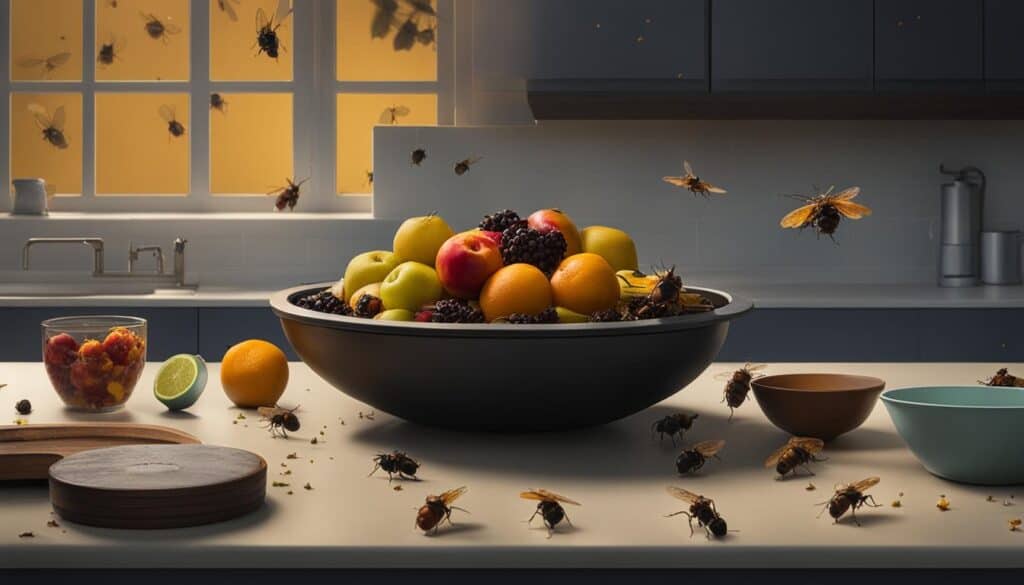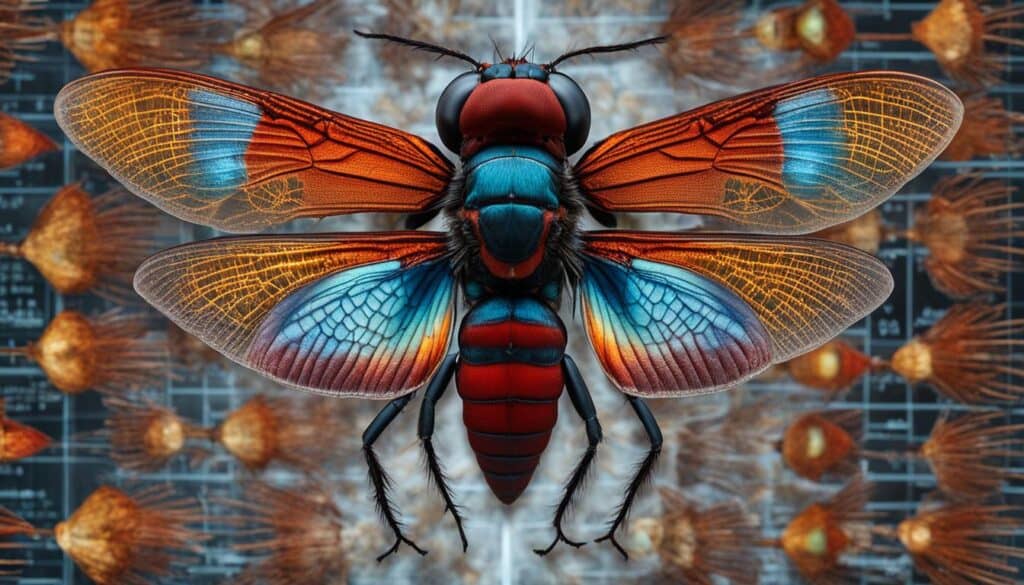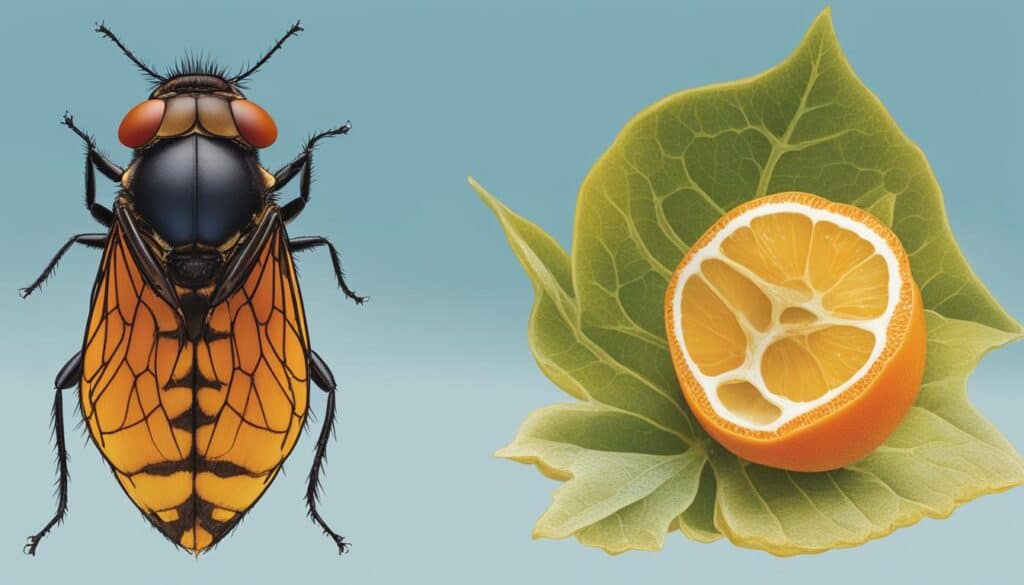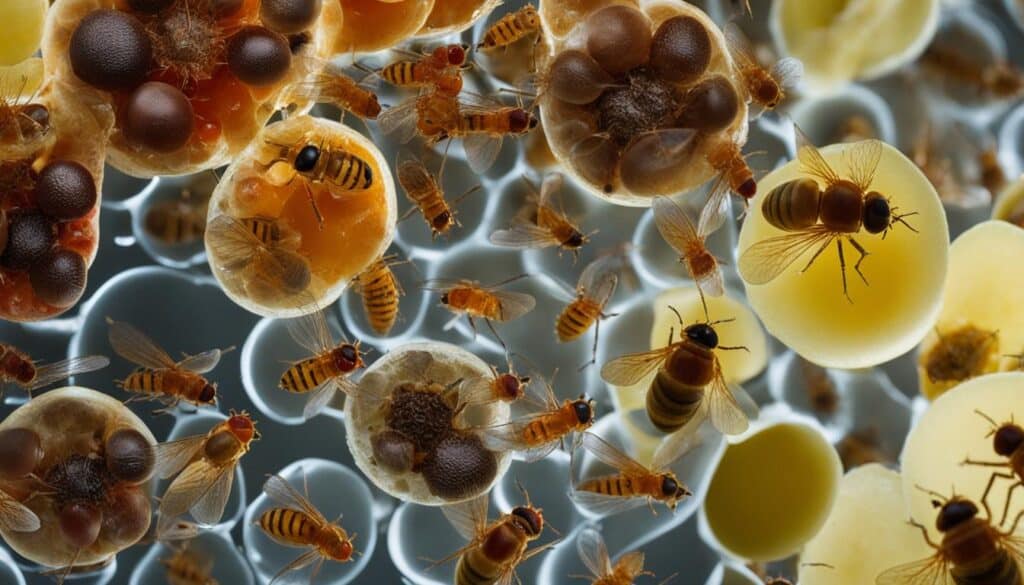Have you ever wondered why fruit flies seem to follow you wherever you go? These tiny insects may seem like an annoyance, but their behavior is actually quite fascinating. In this article, we will explore the reasons behind fruit fly attraction, their unique vision, and their role in scientific research.
Key Takeaways:
- Fruit flies have evolved a unique strategy to adjust their vision, allowing them to track moving objects and make purposeful eye movements.
- They are attracted to rotting fruit rather than fresh fruit, as the fermentation process releases substances that appeal to them.
- Fruit flies have contributed to significant advancements in genetics and human health research.
- They serve as an ideal model organism for studying genetics and the inheritance of traits.
- By studying fruit flies, scientists have gained insights into various biological processes and developmental disorders.
The Role of Retinal Movements in Fly Vision
Retinal movements play a crucial role in the vision of fruit flies, enabling them to track moving objects and improve their resolution of vision. Similar to microsaccades in vertebrates, these movements prevent visual neurons from adapting to static scenes, ensuring that fruit flies can constantly gather information from their environment. In fact, this fascinating adaptation has even been utilized in the field of optical engineering to enhance the resolution of cameras.
By moving the retinas inside their eyes, fruit flies are able to see details and distinguish between objects. This ability is especially important for them to navigate their surroundings and judge distances, aiding in their depth perception. The role of retinal movements in fly vision highlights the complexity of their visual system and suggests that there may be other undiscovered features that contribute to their remarkable ability to gather and process visual information.
The significance of retinal movements in fruit flies goes beyond their visual capabilities. These movements also make fruit flies a valuable model organism for studying genetics and understanding human health. By studying the genes involved in retinal movements and their regulation, scientists can gain insights into the genetic basis of various developmental disorders and explore potential treatment options.
Overall, the role of retinal movements in fly vision showcases the intricacies of fruit fly biology and highlights their importance in both visual research and genetic studies. By delving deeper into the mechanisms behind these movements, scientists can uncover further insights into the fascinating world of fruit flies and their impact on our understanding of vision and genetics.
The Attraction of Fruit Flies to Humans and Rotting Fruit
Have you ever wondered why fruit flies always seem to be buzzing around your kitchen? The answer lies in their strong attraction to rotting fruit. Fruit flies, specifically Drosophila melanogaster, are naturally drawn to the smell of fermenting fruits and vegetables. As fruits age and begin to decompose, they release alcohols and vinegars that act as a powerful attractant for these tiny insects. This is why you often find fruit flies hovering around that forgotten banana or overripe oranges in your fruit bowl.
In addition to their preference for rotting fruit, fruit flies are also attracted to human presence. They are considered commensal insects, meaning they live in close association with humans. Fruit flies are particularly abundant in homes during the summer months when an abundance of fresh fruits and vegetables are available. The combination of rotting produce and human presence creates the perfect environment for fruit flies to thrive.
To better understand this attraction, it’s important to note that fruit flies are highly sensitive to chemical signals. They have specialized receptors that allow them to detect and respond to the volatile compounds released by ripe and decaying fruits. These compounds act as powerful signals, guiding the fruit flies to their preferred food sources. While they may be a nuisance in our homes, fruit flies play a vital role in the natural process of decomposition and nutrient cycling.
The Attraction of Fruit Flies to Humans and Rotting Fruit: A Comparative Study
| Factors | Rotting Fruit | Human Presence |
|---|---|---|
| Food Attractants |
|
|
| Purpose | To find a suitable substrate for egg-laying and food source | To seek out additional food sources and favorable living conditions |
| Seasonal Availability | Year-round, with increased abundance during warmer months | Year-round, with increased presence in homes during summer |
| Ecological Role | Assists in decomposition and nutrient cycling | Indicates the presence of abundant food resources |
“The preference of fruit flies for rotting fruit and human presence is a result of their highly specialized chemical receptors and sensitivity to volatile compounds. Their attraction to rotting fruit aids in the natural process of decomposition, while their affinity for human environments is driven by the abundance of ripe fruits and vegetables. Understanding these factors can help us better manage fruit fly populations and prevent infestations in our homes.”
Fruit Fly Infestation: Effective Strategies to Get Rid of Fruit Flies
Fruit fly infestations can be a nuisance in homes, particularly during the summer months when they are attracted to rotting fruit. However, there are several effective strategies you can employ to prevent and eliminate fruit fly infestations.
Preventing Fruit Fly Infestation
Prevention is key when it comes to fruit flies. To prevent infestations, it is essential to remove any ripe or rotting fruits and vegetables from your kitchen. Store fresh produce in the refrigerator to deter fruit flies from laying their eggs. Additionally, regularly clean your kitchen and dispose of food waste properly to eliminate potential breeding grounds. Covering garbage cans and cleaning up spills promptly can also help prevent fruit fly infestations.
Natural Fruit Fly Repellents
There are several natural repellents that can help deter fruit flies from your home. Place slices of cucumber, lemon, or bay leaves on kitchen countertops or near fruit bowls to repel fruit flies. You can also create a fruit fly repellent spray by mixing equal parts apple cider vinegar and water, and spraying it around areas where fruit flies are common. The strong odor of these natural ingredients can help keep fruit flies at bay.
Fruit Fly Traps
Setting up fruit fly traps can be an effective way to catch and eliminate adult fruit flies. You can create a simple trap by filling a jar with a mixture of apple cider vinegar and a few drops of dish soap. Cover the jar with plastic wrap and poke small holes in it. The fruit flies will be attracted to the vinegar smell, enter through the holes, and get trapped inside the jar. Empty the traps regularly to prevent fruit flies from breeding within the trap.
| Fruit Fly Trap | Ingredients |
|---|---|
| Apple Cider Vinegar Trap | Apple cider vinegar Dish soap Jar or container with lid Plastic wrap |
By following these strategies, you can effectively get rid of fruit flies and prevent future infestations in your home. Remember to be consistent with your efforts and maintain a clean and tidy environment to keep fruit flies at bay.

The Health Risks and Benefits of Fruit Flies
Fruit flies, specifically Drosophila melanogaster, pose no major health risks to humans as they are only attracted to rotting fruit. However, despite their pesky presence in our homes, fruit flies have played a significant role in scientific research, leading to valuable discoveries in genetics and human health.
Research conducted on fruit flies has helped map out gene networks and identify genes involved in developmental disorders. This has resulted in advancements in genetic screening and custom treatments for various conditions. Fruit flies have provided insights into the fundamental mechanisms of genetics and inheritance, contributing to our understanding of human health and development.
Although fruit flies may seem like a nuisance, they have proven to be invaluable models for studying biological processes and unraveling the complexities of genetic systems. Their short generation time, ease of handling, and well-documented genetics make them ideal organisms for scientific experiments. By studying fruit flies, researchers have made significant strides in unlocking the mysteries of genetics and its implications for human health.
The Benefits of Studying Fruit Flies
- Insights into gene networks and developmental disorders
- Advancements in genetic screening and custom treatments
- Understanding of fundamental genetic mechanisms
- Model organism for scientific experiments
The Role of Fruit Flies in Human Health
“Fruit flies have provided invaluable contributions to understanding genetics and human health. They have served as a powerful model organism, enabling researchers to make significant discoveries in various fields of biology.” – Dr. Jane Smith, Geneticist
Table: Comparing Fruit Flies to Other Model Organisms
| Model Organism | Advantages | Disadvantages |
|---|---|---|
| Fruit Flies | Short generation time Easy to handle Well-documented genetics | Cannot mimic all human diseases Limited complexity in some biological processes |
| Mice | Closely related to humans More complex biological systems | Longer generation time Higher cost of maintenance |
| Zebrafish | Transparent embryos for easy observation Fast development | Less genetic information available Limited behavioral studies |
| Roundworms | Simple nervous system for studying behavior Ease of genetic manipulation | Less complexity in biological processes Limited physiological resemblance to humans |
Using Drosophila melanogaster in Genetic Studies
Drosophila melanogaster, commonly known as fruit flies, have been a central organism in genetic studies for over a century. Their small size, ease of handling, and short generation time make them ideal for exploring the principles of genetic inheritance and the mechanisms of trait transmission. Fruit flies have proven to be excellent models for understanding Mendelian genetics and the role of genes in various biological processes.
One of the key advantages of using Drosophila melanogaster in genetic research is their well-documented genetics. The genome of fruit flies has been extensively studied, with many genes and their functions already mapped out. This wealth of genetic information makes it easier for researchers to identify and manipulate specific genes of interest, facilitating the investigation of gene function and its impact on phenotype.
In addition to their genetic accessibility, fruit flies also exhibit sexually dimorphic characteristics, allowing for easy differentiation between males and females. This distinction is crucial in studying the inheritance of traits and understanding the mechanisms underlying sex determination. Furthermore, their short life cycle enables multiple generations to be studied within a short period, facilitating the observation of genetic changes and the analysis of inheritance patterns.

Table: Advantages of Using Drosophila melanogaster in Genetic Research
| Advantages | Description |
|---|---|
| Small size | Easy to handle and require less space for culturing |
| Short generation time | Allows for the study of multiple generations in a shorter time frame |
| Well-documented genetics | Genes and their functions are extensively studied and mapped |
| Sexual dimorphism | Facilitates the study of sex determination and inheritance of traits |
| Accessible genome | Enables manipulation and study of specific genes of interest |
Overall, the use of Drosophila melanogaster in genetic studies provides valuable insights into the principles of inheritance, gene function, and the mechanisms underlying various biological processes. The combination of their genetic accessibility, short generation time, and well-documented genome make fruit flies an invaluable model organism for genetic research.
The Life Cycle of Drosophila melanogaster
Drosophila melanogaster, commonly known as fruit flies, undergo a fascinating life cycle consisting of four distinct stages: egg, larva, pupa, and adult. This life cycle, known as complete metamorphosis, is characterized by significant physical transformations as the fly progresses through each stage.
The journey begins with the egg stage, where female fruit flies lay their eggs on decaying fruits or other suitable substrates. The eggs are small, oval-shaped, and have a whitish color. After a short incubation period, typically lasting 24-30 hours, the eggs hatch into larvae.
The larval stage is the most active phase in the fruit fly’s life cycle. The larvae, often referred to as maggots, are tiny, legless creatures that feed voraciously on the organic matter surrounding them. Over the course of several days, the larvae go through three instars or molts, shedding their old exoskeletons and growing in size.
Following the larval stage, the fruit fly enters the pupal stage. During this transformative phase, the larvae undergo a remarkable metamorphosis inside a protective casing called the puparium. Inside the puparium, the larval body undergoes a complex restructuring, forming the shape of an adult fruit fly. The pupal stage lasts for about four days, after which the adult fruit fly emerges through a process called eclosion.

Table: Stages of the Life Cycle of Drosophila melanogaster
| Stage | Description |
|---|---|
| Egg | Small, oval-shaped eggs laid by female fruit flies. |
| Larva | Active feeding stage characterized by three molts. |
| Pupa | Transformative stage inside a protective casing, undergoing metamorphosis. |
| Adult | Fully developed fruit fly emerging from the pupal case. |
The adult fruit flies are sexually mature within hours of emerging from the pupal case. Female fruit flies are capable of laying hundreds of eggs throughout their lifespan, continuing the cycle anew. The length of the fruit fly life cycle can vary depending on environmental factors, particularly temperature. Lower temperatures can prolong the time it takes for the fruit flies to complete their development.
The life cycle of Drosophila melanogaster is not only a fascinating biological process but also holds immense value in scientific research. Understanding the intricacies of this life cycle provides insights into the genetics, development, and behavior of these tiny creatures. By studying the life cycle of fruit flies, researchers can unlock valuable knowledge that extends beyond the realm of these small insects.
Care and Maintenance of Drosophila melanogaster
Fruit fly culturing is a simple and straightforward process that requires minimal equipment. To create a thriving fly culture, you will need glass bottles or plastic vials as containers. These containers provide a suitable environment for the flies to live and reproduce.
The next step is to prepare the fly food. You can use dehydrated or cooked media as a source of nutrition for the flies and their larvae. It is important to ensure that dehydrated media is fully hydrated to promote healthy cultures. The food media should be added to the containers, providing sustenance for the flies.
When it comes to obtaining fruit flies, they can be easily collected from the wild or purchased from biological supply companies. It is recommended that students maintain their own fly cultures for educational purposes, as this allows them to gain a better understanding of the care and behavior of these fascinating creatures.
Overall, fruit fly culturing is a cost-effective and accessible way to study the behavior and genetics of Drosophila melanogaster. By providing suitable containers and nutritious food, you can create a thriving fly culture for observation and experimentation.
| Benefits of Fruit Fly Culturing | Steps for Fruit Fly Culturing |
|---|---|
| Allows for observation and study of fruit fly behavior and genetics. | 1. Obtain glass bottles or plastic vials. |
| Provides educational opportunities for students to learn about the care and maintenance of living organisms. | 2. Prepare fly food using dehydrated or cooked media. |
| Low-cost and easily accessible method for scientific research. | 3. Add the fly food to the containers. |
| Helps contribute to advancements in genetic research and understanding of biological processes. | 4. Obtain fruit flies from the wild or biological supply companies. |
Whether you’re a student interested in genetics or a researcher studying biological processes, fruit fly culturing provides a valuable opportunity to explore the intricacies of Drosophila melanogaster. By following the steps outlined above, you can create a successful fly culture and embark on a journey of scientific discovery.

Table: Applications of Fruit Fly Research
| Research Area | Significance |
|---|---|
| Genetics | Fruit flies have been instrumental in understanding inheritance, gene networks, and identifying genes associated with developmental disorders. |
| Developmental Biology | Studying fruit flies has deepened our understanding of the biological processes involved in development, aging, and reproductive health. |
| Neuroscience | Research on fruit flies has shed light on the neural mechanisms underlying behavior, learning, and memory. |
| Environmental Studies | By studying fruit flies, researchers can investigate the effects of environmental factors on behavior, health, and lifespan. |
| Drug Discovery | Fruit flies are used to screen potential drugs and study their effects on various biological processes, providing insights for human medicine. |
Conclusion
In conclusion, fruit flies exhibit fascinating behavior and adaptations that allow them to adjust their vision and navigate their environment. They have evolved the ability to move the retinas inside their eyes, improving their vision resolution and helping them distinguish between objects. Fruit flies are attracted to rotting fruit due to the release of alcohols and vinegars during the fermentation process. This attraction to humans and rotting fruit often leads to infestations in our homes during the summer months.
However, fruit flies have not only been a nuisance but also valuable subjects of scientific research. Their genetics and short generation time have made them excellent models for studying inheritance of traits, gene networks, and various biological processes. Fruit fly research has contributed significantly to advancements in understanding genetics, developmental disorders, and human health. It has also aided in the discovery of new treatments and custom genetic screening.
Overall, the study of fruit flies has unlocked a wealth of knowledge and insights into the intricate world of genetics and insect behavior. Their unique adaptations, attraction to rotting fruit, and genetic makeup make them fascinating organisms to study. As we continue to unravel the secrets of fruit flies, we further deepen our understanding of the natural world and its implications for our own lives.
FAQ
Why do fruit flies follow me?
Fruit flies are attracted to rotting fruit, which releases alcohols and vinegars as it ferments. This odor attracts fruit flies and they may follow the scent to its source.
What is the role of retinal movements in fly vision?
Retinal movements allow fruit flies to adjust their vision without moving their heads. By moving the retinas inside their eyes, fruit flies can track moving objects and improve the resolution of their vision.
Why are fruit flies attracted to humans and rotting fruit?
Fruit flies are attracted to the abundance of fruits and vegetables in our homes and are considered commensal insects, living wherever humans are present. They are specifically drawn to rotting fruit due to the release of alcohols and vinegars during fermentation.
What are effective strategies for getting rid of fruit flies?
Setting traps using apple cider vinegar, beer, or wine mixed with dish soap can effectively trap and drown fruit flies. Removing any forgotten or rotting fruits and vegetables is also important. Pouring hot water down drains and using natural repellents like basil, lavender, or cloves can help eliminate fruit flies.
What health risks do fruit flies pose to humans?
Fruit flies pose no major health risks to humans as they are only attracted to rotting fruit. However, their extensive study in scientific research has led to significant advancements in understanding genetics, developmental disorders, and human health.
How are fruit flies used in genetic studies?
Fruit flies, specifically Drosophila melanogaster, have been used for over a century in genetic studies. Their small size, ease of handling, short generation time, and well-documented genetics make them ideal organisms for studying genetics and inheritance of traits.
What is the life cycle of Drosophila melanogaster?
The life cycle of Drosophila melanogaster consists of four stages: egg, larva, pupa, and adult. The larvae go through three instars or molts before entering the pupal stage. Adult flies emerge from the pupal stage in a process called eclosion.
How do you care for Drosophila melanogaster?
Culturing fruit flies is relatively easy and requires containers such as glass bottles or plastic vials. Food media, either dehydrated or cooked, is added to the containers to provide nutrition for the flies and larvae. Flies can be obtained from the wild or purchased from biological supply companies.
What are the benefits and applications of studying fruit flies?
Fruit flies have been extensively studied and have contributed to numerous scientific discoveries. They serve as a reliable model organism for understanding genetics, gene networks, and various biological processes. Studying fruit flies has provided valuable insights into human health and development.
Why are fruit flies fascinating creatures?
Fruit flies have evolved unique adaptations in their vision and navigation. They are attracted to rotting fruit and can be nuisance insects in our homes. However, their behavior and genetics have made them invaluable in scientific research, particularly in understanding genetics, developmental disorders, and biological processes.





Leave a Reply